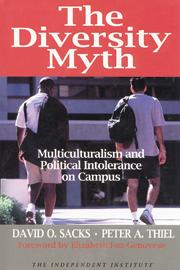U.S. News & World Report’s annual college guide says the cost of an undergraduate degree from a top college now exceeds $100,000. At more than $25,000 per year—about the sticker price for a BMW 325i—many parents will have to reconsider whether that rare admission offer from a Harvard, Yale, Brown, Duke or Stanford is worth the expense.
When those who decide to scrimp, save and sacrifice—and perhaps take out a second mortgage—find out what their money is buying, they may be shocked to leam that $l00,000 does not buy a better education, but a worse one.
ln fact, at schools like Stanford University, consistently ranked in the top five by U.S. News, “multiculturalism” has overrun most of the major humanities and social sciences departments. The cumulative effect has been a kind of institutionalized silliness.
The Stanford curriculum—considered the standard for emulation by activist educators across the country—boasts of literature courses that filter Shakespeare through the lens of lesbianism, American history courses that don’t teach about the Constitution, English classes where students write grant proposals for environmental groups, and psychology courses that give high marks for finding “gender discrepancies” in pizza parlors. ln short, much of the undergraduate humanities curricula have been transformed into a vehicle for shameless polilicization and in- doctrination.
Consider the multiple track “Cultures, ideas, and Values” (ClV) program, a 15-unit requirement (about $8,000 per student) with which Stanford replaced its Western Culture core in capitulation to the forces of political correctness in the 1980s. Although Plato and Aristotle are still read, they are primarily used to contrast the “logocentrism” of Western philosophers (as in making oneself understood through words that actually mean things), with the more holistic approach of Australian Aborigines, whose unwritten “philosophy” must be explained to students by (presumably “logocentric”) Western anthropologists. The Bible is still read in all the CIV tracks, but many classes teach that Genesis is rife with sexism, and some sections even make the Apostle Paul politically correct by saying he may have been homosexual.
“Black Hair as Culture and History” addresses how black hair has interacted with the black presence in this country, and how it “has played a role in the evolution of black society.” Lectures include “The Rise of the Afro,” and “Fade-o-rama, Braiding and Dreadlocks.” “l couldn’t have taught this class l0 years ago,” Kennell Jackson, the course instructor explains. “But people don’t look at me like l’m crazy anymore.”
More examples: History 267, “The History of Rights in the United States,” was so busy extolling l960s protests that students never studied the Declaration of Independence or the Constitution. “Religions in America” devoted whole lectures to Shamanism, the peyote cult, and the Kodiak sect, but not a single word to the Catholic Church. When discussed at all, Christianity was viewed from a feminist or gay “perspective” through such works as “Jesus Acted Up: A Gay and Lesbian Manifesto.”
ln Psychology l67D, students became “contraceptive peer counselors,” demonstrating their skills by placing condoms on a plastic penis at dorm meetings. ln Stanford’s mandatory freshman English classes, students are required to write grant proposals for their professors’ favorite community service agencies, including homeless advocacy projects, AlDS support groups, and environmental action leagues.
Our personal favorite is Psy- chology H6, ”The Psychology of Gender.” ln her Spring 1994 class, instructor Laura Carstenson required students to complete a group research project. Her favorite was entitled “Gender Discrepancies in Pizza Consumption,” a study examining the number of pizza slices consumed by males vs. females.
Graduation requirements at Stanford don’t allow the conscientious student to avoid such courses through careful selection. And since A’s are awarded as a matter of routine, all students face powerful pressure to take them to boost their grade-point averages. This is the model being held up for emulation at colleges across the country.
Meanwhile, serious students are hard pressed to find answers to ancient and modern questions: What constitutes justice, rather than propaganda about the size of welfare payments; what the Bible teaches about mau‘s political nature, rather than speculation about the Apostle Paul’s sexual orientation; or the Founder’s view of slavery and race relations, instead of courses on hairstyles.
At $100,000 per degree, is that too much to ask?








